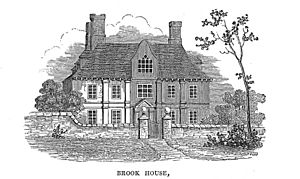George Lipscomb facts for kids
George Lipscomb (born 1773, died 1846) was an English doctor and a historian. He was especially known for writing a detailed history book about the county of Buckinghamshire in England.
George Lipscomb's Life
George Lipscomb was born on January 4, 1773, in a place called Quainton in Buckinghamshire. His father, James Lipscomb, was a surgeon in the Royal Navy. George went to schools in Quainton and Aylesbury. He learned some medical skills from his father. Later, he studied surgery in London with a famous surgeon named Sir James Earle.
In 1792, George Lipscomb became a house-surgeon at St. Bartholomew's Hospital. This meant he lived and worked at the hospital. In 1794, he joined the North Hants Militia as a lieutenant. This was a local army group. By 1798, he was a captain in the Warwickshire volunteer infantry. He even wrote a speech for them about their duty to their country. In the same year, he became a deputy recorder (a type of judge) in Warwick.
In 1806, Lipscomb earned his M.D. degree from Marischal College, Aberdeen. This meant he was now a medical doctor. Around 1811, he helped edit a newspaper called the National Adviser. He also came up with an idea for a society to help farming. He won an award and a silver medal for his idea from the Board of Agriculture.
George Lipscomb passed away on November 9, 1846. He was buried in the graveyard of St. George the Martyr, Southwark. He was a friend of Henry Tattam and a cousin of William Lipscomb.
George Lipscomb's Writings

Lipscomb's most important work was The History and Antiquities of the County of Buckingham. This huge book was based on his own research and notes he received from Edward Cooke. Many people signed up to buy the book before it was finished. The first part came out in 1831. However, Lipscomb had money problems, so the work had to stop.
Luckily, a publisher named John Bowyer Nichols helped him. Before Lipscomb died, the last part of the book was being printed. The book ended up being four large volumes, published in 1847.
He also wrote other books about places:
- A Journey into Cornwall (1799)
- A Journey into South Wales (1802)
- A Description of Matlock-bath (1802) – This book described a famous spa town.
- A Journey round the Coast of Kent (1818)
- The Sandgate, Hythe, and Folkestone Guide (1823)
Lipscomb also wrote many medical books:
- An Essay on the Nature and Treatment of a putrid, malignant Fever which prevailed at Warwick in 1798 (1799) – About a fever in Warwick.
- Observations on the History and Cause of Asthma (1800) – About breathing problems.
- Inoculation for the Small-pox vindicated (1805) – Supporting smallpox inoculation.
- A Manual of Inoculation for the use of the Faculty and Private Families (1806)
- A Dissertation on the non-Infallibility of the Cow-pox (1806) – Questioning the new cowpox vaccine.
- Cow-pox exploded (1806) – Another book questioning the cowpox vaccine.
- A Dissertation on the Failure and Mischiefs of the Cow-pox (1806)
- Cautions and Reflections on Canine Madness (1807) – About rabies and how to prevent it.
- A History of Canine Madness and Hydrophobia (1809)
- Observations on Contagion (1819) – About how diseases spread, like the plague.
- A Grammar of Medicine
In 1832, Lipscomb gave talks about cholera at places like the London Mechanics' Institution. He then published these talks as a book called On the Nature, Symptoms, Treatment, and Cure of Cholera Morbus. He also included his letters with Lord Melbourne about the topic.
Some of his other writings included:
- The Grey Friar, or the Black Spirit of the Wye (1810)
- Modern Times, or Anecdotes of the English Family
- The Capricious Mother
- Observations on the High Price of Provisions and the Monopoly of Farms – About food prices and farming.
Lipscomb also wrote articles for the Gentleman's Magazine and other publications. He edited the Clerical Guide in 1821. He even wrote sermons for other clergymen and composed hymns for charity schools.
George Lipscomb's Family
In 1803, George Lipscomb married Sarah. She was the widow of Richard Hopkins and the daughter of Thomas Wells, both from Stratford-upon-Avon. George and Sarah did not have any children. When Sarah died in 1834, her money, which George largely depended on, went back to her own family.

